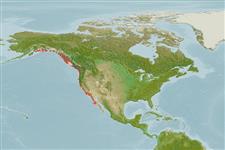Environment: milieu / climate zone / depth range / distribution range
Ecología
marino demersal; rango de profundidad ? - 30 m (Ref. 2850). Subtropical; 61°N - 20°N, 154°W - 114°W
Eastern Pacific: northern British Columbia, Canada to central Baja California, Mexico, including Guadalupe Island, off north central Baja California.
Tamaño / Peso / Age
Maturity: Lm ? range ? - ? cm
Max length : 22.0 cm TL macho / no sexado; (Ref. 2850)
Espinas dorsales (total): 7 - 9; Radios blandos dorsales (total): 13-16; Espinas anales 3; Radios blandos anales: 21 - 24; Vértebra: 31 - 34. Color variable, olive brown to coppery above lateral line, with dark pigment under each scale, bright below lateral line; dark on axil; fins either pale or rosy (Ref. 6885).
Found among giant kelp, usually up in kelp canopy. Feed on small crustaceans, especially ones that live on kelp. Also a cleaner which picks external parasites from other fishes. Usually occur in large aggregations in summer (Ref. 2850). Viviparous, female carries the developing young (Ref. 205).
Life cycle and mating behavior
Madurez | Reproducción | Puesta | Huevos | Fecundidad | Larva
Viviparous, female carries the developing young (Ref. 205).
Eschmeyer, W.N., E.S. Herald and H. Hammann, 1983. A field guide to Pacific coast fishes of North America. Boston (MA, USA): Houghton Mifflin Company. xii+336 p. (Ref. 2850)
IUCN Red List Status (Ref. 130435)
Threat to humans
Harmless
Human uses
Acuario: Acuarios públicos
Más información
ReferenciasAcuiculturaPerfil de acuiculturaRazasGenéticaElectrophoresesheritabilidadEnfermedadesProcesamientoNutrientsMass conversion
Herramientas
Special reports
Download XML
Fuentes de Internet
Estimates based on models
Preferred temperature (Ref.
123201): 8.4 - 18.3, mean 10.7 °C (based on 229 cells).
Phylogenetic diversity index (Ref.
82804): PD
50 = 0.7500 [Uniqueness, from 0.5 = low to 2.0 = high].
Bayesian length-weight: a=0.01318 (0.00559 - 0.03107), b=3.05 (2.84 - 3.26), in cm total length, based on LWR estimates for this (Sub)family-body shape (Ref.
93245).
Nivel trófico (Ref.
69278): 3.5 ±0.50 se; based on food items.
Resiliencia (Ref.
120179): Alto, población duplicada en un tiempo mínimo inferior a 15 meses (tm=1).
Fishing Vulnerability (Ref.
59153): Low vulnerability (12 of 100).
Nutrients (Ref.
124155): Calcium = 155 [85, 298] mg/100g; Iron = 1.43 [0.91, 2.36] mg/100g; Protein = 19.1 [18.3, 20.0] %; Omega3 = 0.368 [0.238, 0.576] g/100g; Selenium = 20.5 [11.1, 39.0] μg/100g; VitaminA = 13.1 [4.8, 35.6] μg/100g; Zinc = 0.956 [0.691, 1.351] mg/100g (wet weight);
